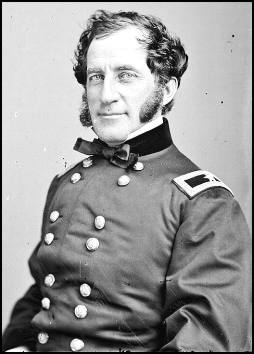Abram Duryée facts for kids
Quick facts for kids
Abram Duryée
|
|
|---|---|
 |
|
| Born | April 29, 1815 New York City, New York |
| Died | September 27, 1890 (aged 75) New York City, New York |
| Place of burial |
Green-Wood Cemetery, Brooklyn, New York
|
| Allegiance | United States of America Union |
| Service/ |
United States Army Union Army |
| Years of service | 1861–1863 |
| Rank | |
| Commands held | 5th New York Volunteer Infantry |
| Battles/wars | American Civil War |
| Other work | New York City Police Commissioner |
| Signature | |
Abram Duryée (April 29, 1815 – September 27, 1890) was an important Union Army general during the American Civil War. He led one of the most famous Zouave regiments, the 5th New York Volunteer Infantry. After the war, he became the New York City Police Commissioner.
Contents
Abram Duryée's Early Life and Military Start
Abram Duryée was born in New York City in 1815. His family had a long history of serving in the military. His grandfather fought in the American Revolutionary War. His father and two uncles were officers in the War of 1812.
Education and Business Career
Abram went to grammar school at Columbia College. After finishing school, he became a successful merchant. He made a lot of money importing mahogany wood into New York.
Joining the Militia
In 1833, Abram joined the New York State Militia. This was a group of citizen soldiers. He first served in the 142nd New York Regiment. Five years later, he moved to the 27th Regiment. This regiment is known today as the 7th Regiment.
Abram started as a private, which is the lowest rank. He worked his way up to Colonel in 1859. During his time in the militia, he led his regiment during the Astor Place Riot. This was a large public disturbance in New York City. He was wounded twice during this event. He left the militia in 1859, even though his fellow soldiers wanted him to stay.
Abram Duryée's Role in the Civil War
When the American Civil War began, Abram Duryée quickly formed a new regiment. This was the 5th New York Volunteers. He gathered the soldiers in less than a week. On May 14, 1861, he became its colonel.
Duryée's Zouaves
His regiment was one of several Zouave units. Zouaves were soldiers who wore colorful, North African-inspired uniforms. They were known for their bravery and unique look. Duryée's regiment became famous as "Duryée's Zouaves." They fought in their first major battle at Big Bethel.
Rising Through the Ranks
Abram Duryée was promoted to brigadier general on August 31, 1861. President Abraham Lincoln approved his promotion. The U.S. Senate confirmed it in February 1862. He was given command of a brigade. A brigade is a large group of soldiers. This brigade was part of a division led by General James B. Ricketts.
Duryée fought in many important battles. These included the Battle of Cedar Mountain and the Second Battle of Bull Run. He was known for being brave and often in the middle of the fighting. He was wounded at Second Bull Run, South Mountain, and Antietam. At the Battle of Antietam, he took over as division commander when General Ricketts was injured.
Leaving the Army
After the Battle of Antietam, Duryée took a short break. When he returned, he found his brigade was under a different general. This general, John Gibbon, was junior to Duryée in rank. Duryée felt this was unfair. He resigned from the army on January 5, 1863. His request to get his old command back was denied.
Even though he resigned, he was later recognized for his service. In 1866, President Andrew Johnson nominated him for a special honor. He was appointed to the honorary rank of brevet major general of volunteers. This honor was confirmed by the Senate. He also turned down offers to lead other regiments after the war.
Abram Duryée's Later Career as Police Commissioner
In 1873, Abram Duryée was appointed New York City Police Commissioner. This was a very important job. It meant he was in charge of the city's police force.
The Tompkins Square Protest
During his time as commissioner, a large labor protest happened. This was on January 13, 1874, in Tompkins Square Park. Workers were protesting for better conditions. Commissioner Duryée led 1,600 policemen to break up the protest.
The meeting's permit had been canceled. However, the protesters did not know this. Commissioner Duryée led police into the crowd. He ordered the protesters to leave. The police then began to attack the crowd. They used batons and rode horses into the people.
Samuel Gompers, a famous labor leader, described the event. He said police attacked men, women, and children. He himself barely escaped injury. Police arrested 46 protesters. Ten of them were charged with various offenses.
The protest organizers criticized Commissioner Duryée. They said he "charged his police upon inoffensive workingmen." Duryée defended the police's actions. He said it was "the most glorious sight I ever saw." He praised how the police broke up the crowd.
In 1884, Duryée also worked as a dockmaster. Abram Duryée died in New York in 1890. He is buried in Green-Wood Cemetery in Brooklyn.
Abram Duryée's Family Life
General Abram Duryée and his wife, Caroline Elizabeth Allen Duryee, had five children. Their son, Jacob Duryée, also served in the Civil War. He was a lieutenant colonel. Like his father, Jacob was also given the honorary rank of brevet brigadier general of volunteers.
Their other children were Adelaide Allen Duryee, Caroline Antoinette Duryee, William Allen Duryee, and Cordelia Wetmore Duryee.
See also
- List of American Civil War generals (Union)


